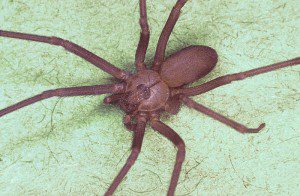Bug of the Month for November: Brown Recluse Spider
Welcome back to this month’s installment for Bug of the Month. Last month, we talked about the wolf spider. We said that wolf spiders were often confused with brown recluses, so we decided that November would be all about the brown recluse!
Brown recluses are quite a bit more dangerous than wolf spiders, but are rarely ever deadly. Here are a few ways to identify and get rid of brown recluses.
What do brown recluses look like?
Brown recluses are, well, brown! But seriously, they are usually a centimeter long and half a centimeter wide, and they are known for having a violin-shaped dark spot on their back toward their head. This is why they got the nickname “fiddleback spiders”. The spot gets darker the older the spider is.
While most spiders have eight eyes, the brown recluse only has six. This is perhaps the most distinguishable characteristic of the brown recluse. Perhaps even more so than the “violin”.
Another distinguishing feature is their legs. Brown recluses’ legs are slightly slanted when they are relaxed. The spider’s entire body is covered in tiny, velvety hairs.
How do brown recluse spiders behave?
Brown recluses get the “recluse” part of their name because they generally tend to avoid human interaction. They hide in dark places in and around buildings and can go for long times without eating.
The female brown recluse mates only once and continues to bear offspring. There are often large numbers of brown recluses that are never spotted due to their reclusive nature.
Where do brown recluses live?
Brown recluse spiders live in the south-central and southeastern United States and are very rarely seen anywhere else.
The brown recluse spider often lives in manmade structures and close to the ground. The most likely places to find them are in basements, under porches, and deep inside closets.
What does a brown recluse bite look like, and what should I do if I am bitten?
Most of the time, the brown recluse bite is very minor and may turn red. Sometimes there might not even be a reaction at all. However, because you never know how you will react, you should seek immediate medical attention.
Some individuals who are sensitive to the venom may see a white blister arise. The area around the blister may harden. If not treated immediately, some blue spots surrounded by redness may appear, giving the brown recluse bite a “red, white, and blue” look.
In rare cases, the bite may become gangrenous and leave a large, open wound.
If you are bitten by a brown recluse, wash the bite immediately and seek medical attention, even if you aren’t feeling symptoms because it can sometimes take a few hours for the symptoms to start.
How can I get rid of brown recluses.
To prevent spider infestations, all doors and windows should be sealed. Also, try not to leave food and waste lying around. If you do see a brown recluse infestation, there are several products that can be used to kill spiders and prevent them from coming back.
Unlike the wolf spider, the brown recluse tends to stay in packs. There can be hundreds of brown recluse spiders in a single infestation, most of which will never be seen. If you have a brown recluse infestation, don’t hesitate to call Absolute Pest Control at (615)-220-1933 or click here to schedule an appointment.



